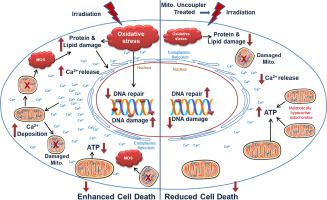Biochimica et Biophysica Acta (BBA) - Bioenergetics ( IF 4.3 ) Pub Date : 2020-10-13 , DOI: 10.1016/j.bbabio.2020.148325 Yogesh Rai , Anita , Neeraj Kumari , Shashwat Singh , Namita Kalra , Ravi Soni , Anant Narayan Bhatt

|
Ionizing radiation (IR) induced mitochondrial dysfunction is associated with enhanced radiation stimulated metabolic oxidative stress that interacts randomly with intracellular bio-macromolecules causing lethal cellular injury and cell death. Since mild mitochondrial uncoupling emerged as a valuable therapeutic approach by regulating oxidative stress in most prevalent human diseases including ageing, ischemic reperfusion injury, and neurodegeneration with comparable features of IR inflicted mitochondrial damage. Therefore, we explored whether mitochondrial uncoupling could also protect from IR induced cytotoxic insult. Our results showed that DNP, BHT, FCCP, and BAM15 are safe to cells at different concentrations range depending on their respective mitochondrial uncoupling potential. Pre-incubation of murine fibroblast (NIH/3T3) cells with the safe concentration of these uncouplers followed by gamma (γ)-radiation showed significant cell growth recovery, reduced ROS generation, and apoptosis, compared to IR treatment alone. We observed that DNP pre-treatment increased the surviving fraction of IR exposed HEK-293, Raw 264.7 and NIH/3T3 cells. Additionally, DNP pre-treatment followed by IR leads to reduced total and mitochondrial oxidative stress (mos), regulated calcium (Ca2+) homeostasis, and mitochondrial bioenergetics in NIH/3T3 cells. It also significantly reduced macromolecular oxidation, correlated with the regulated ROS generation and antioxidant defence system. Moreover, DNP facilitated DNA repair kinetics evidenced by reducing the number of γ-H2AX foci formation and fragmented nuclei with time. DNP pre-incubation restrained the radiation induced pro-apoptotic factors and inhibits apoptosis. Our findings raise the possibility that mild mitochondrial uncoupling with DNP could be a potential therapeutic approach for radiation induced cytotoxic insult associated with an altered mitochondrial function.
中文翻译:

轻度线粒体解偶联通过减弱氧化应激和线粒体损伤,防止电离辐射诱导的细胞死亡
电离辐射(IR)引起的线粒体功能障碍与辐射刺激的代谢氧化应激增强有关,后者与细胞内生物大分子随机相互作用,导致致命的细胞损伤和细胞死亡。由于轻度线粒体解偶联通过调节大多数老龄人类疾病(包括衰老,局部缺血再灌注损伤和神经退行性变)中的氧化应激而成为一种有价值的治疗方法,具有IR引起线粒体损伤的类似特征。因此,我们探讨了线粒体解偶联是否还可以保护免受IR诱导的细胞毒性损伤。我们的结果表明,DNP,BHT,FCCP和BAM15对于不同浓度范围的细胞都是安全的,这取决于它们各自的线粒体解偶联潜能。与单独的IR治疗相比,使用安全浓度的这些解偶联剂对小鼠成纤维细胞(NIH / 3T3)进行预培养,然后进行伽玛(γ)辐射,可显着恢复细胞生长,减少ROS生成和细胞凋亡。我们观察到DNP预处理增加了IR暴露的HEK-293,Raw 264.7和NIH / 3T3细胞的存活率。此外,先进行DNP预处理再进行IR,可降低总和线粒体的氧化应激(mos),调节钙(Ca2+)NIH / 3T3细胞的体内稳态和线粒体生物能。它还显着减少了大分子氧化,这与调节的ROS生成和抗氧化剂防御系统有关。此外,DNP通过减少γ-H2AX灶形成的数量和随时间变化的核分裂而促进了DNA修复动力学。DNP预孵育可抑制辐射诱导的促凋亡因子并抑制细胞凋亡。我们的发现增加了轻度线粒体与DNP脱钩的可能性,这可能是与线粒体功能改变相关的辐射诱导的细胞毒性损伤的潜在治疗方法。



























 京公网安备 11010802027423号
京公网安备 11010802027423号